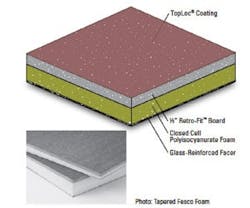What Will the New Year Bring to the Roofing Industry?
With the arrival of a new year, it is time to evaluate those roofing issues that have recently changed, as well as those that reflect long-term stability and durability.
How Much Insulation is Enough?
Worthwhile Downloads
The September 2013 issue of Interface Magazine, the journal of RCI, noted many transitions taking place in the building envelope.
The 2012 International Building Code (IBC), as cited in the Interface article, provides climate zone maps of the U.S. that list the required R-values when the thermal insulation in a commercial roof system is:
- Above the roof deck
- Beneath the deck in a metal roof system
- On the floor of an attic
The December issue of Roofing Contractor suggests a systematic approach to insulating new structures and retrofitting existing roof inventory.
Looking backwards, the oil embargo of 1972-1973 highlighted the sudden demand for energy conservation. A typical roof structure at that time was one with perhaps 3/4 to 1 inch of roof insulation, generally wood fiber, perlite, or glass fiber, with R-values around 3 per inch of thickness. On the West Coast, fiberglass underdeck batts with an R-value of 7 might be used.
Hybrid systems used perlite or glass fiber as a fire barrier, laminated to the desired thickness of newly introduced polyurethane foam. Today, we have reintroduced such systems using cover boards, usually of gypsum board.PageBreak
Today and Tomorrow
Richard (Dick) L. Fricklas was technical director emeritus of the Roofing Industry Educational Institute prior to his retirement. He is co-author of The Manual of Low Slope Roofing Systems, and continues to participate in seminars for the University of Wisconsin and RCI Inc., the Institute of Roofing, Waterproofing, and Building Envelope Professionals. His honors include the Outstanding Educator Award from RCI, William C. Cullen Award and Walter C. Voss Award from ASTM, the J. A. Piper Award from NRCA, and the James Q. McCawley Award from the MRCA. Dick holds honorary memberships in both ASTM and RCI Inc.
Cellular foams of polystyrene and urethane/polyisocyanurate now meet the demands of greatly increased R-values. Extruded polystyrene is generally quoted at an R-value of 5.0 per inch, while isoboards are quoted at 5.6 (recently downgraded from as much as 7.2 per inch). A roof in climate zone 5, for example, now requires an R of 25, or 4.46 inches of thickness for isoboards. (Note that wood nailers need to meet this required thickness, as do wall scuppers, equipment curbs, and other components.)
Mark Graham, associate executive director of technical services for the National Roofing Contractors Association (NRCA), recommends that contractor members of NRCA order insulation materials by thickness, not R-value, due to confusion in the marketplace over long-term thermal resistance.
Speaking of resources on codes, wind uplift, air and vapor barriers and much more, we recommend that readers consider attending one of the upcoming roofing conventions. The NRCA program is set for the week of Feb. 26 in Las Vegas, and RCI’s program is in Anaheim during the week of March 24.
And don’t forget to scan the upcoming webinars on BuildingsVIP for the latest information on building envelope requirements.
Specify the Right Amount of Roof Insulation
Let codes, materials, and performance guide you.
8 Tips for a Successful Roof Audit
How to ensure a safe and successful inspection this spring.
In-House Roof Management
Five steps to extend roof life.
About the Author
Richard L. Fricklas
Richard (Dick) L. Fricklas received a Lifetime Achievement Award and fellowship from RCI in 2014 in recognition of his contributions to educating three generations of roofing professionals. A researcher, author, journalist, and educator, Fricklas retired as technical director emeritus of the Roofing Industry Educational Institute in 1996. He is co-author of The Manual of Low Slope Roofing Systems (now in its fourth edition) and taught roofing seminars at the University of Wisconsin, in addition to helping develop RCI curricula. His honors include the Outstanding Educator Award from RCI, William C. Cullen Award and Walter C. Voss Award from ASTM, the J. A. Piper Award from NRCA, and the James Q. McCawley Award from the MRCA. Dick holds honorary memberships in both ASTM and RCI Inc.

